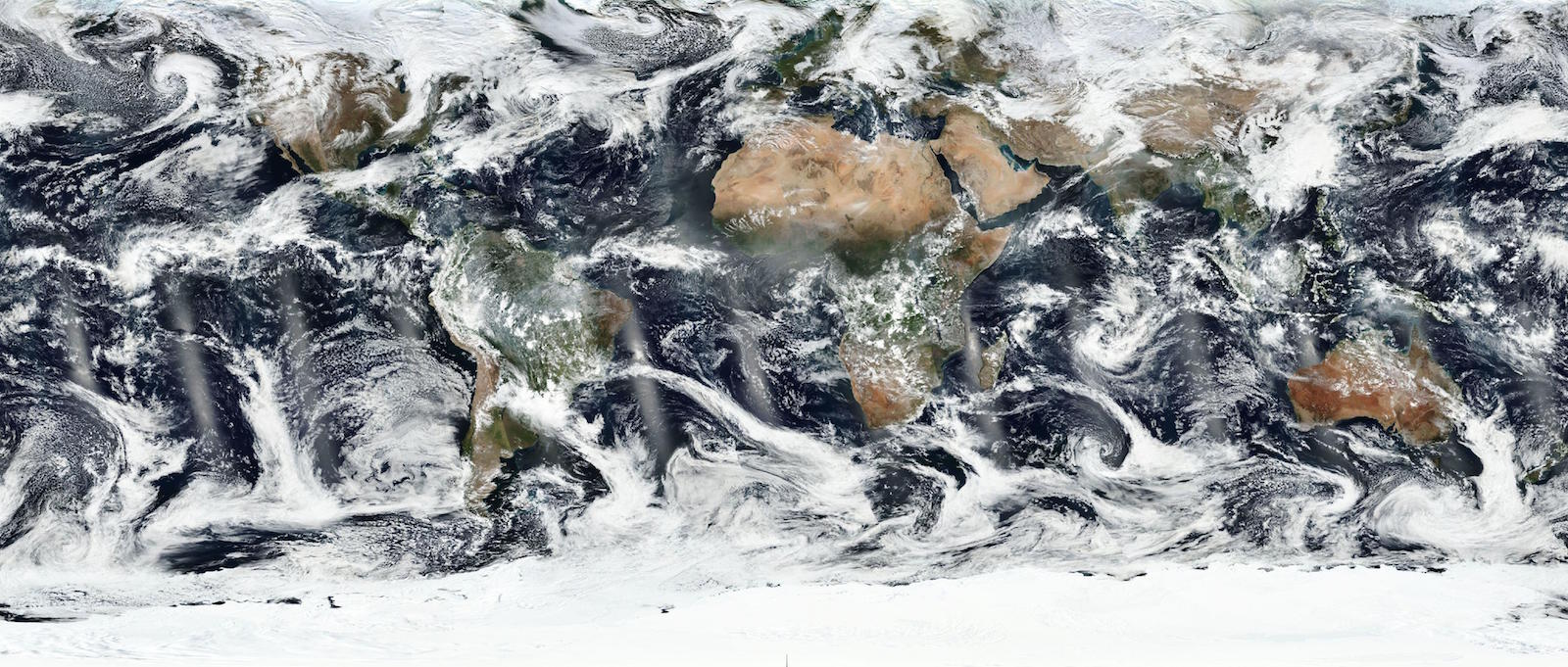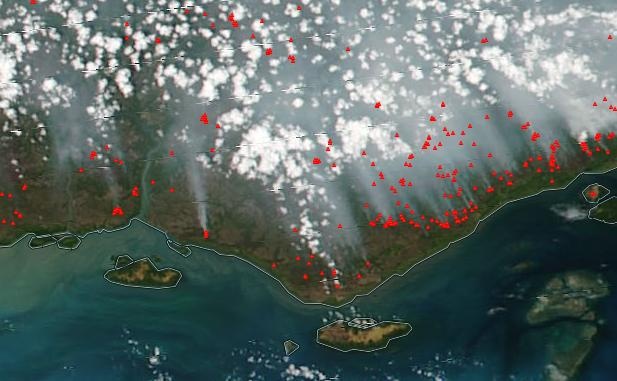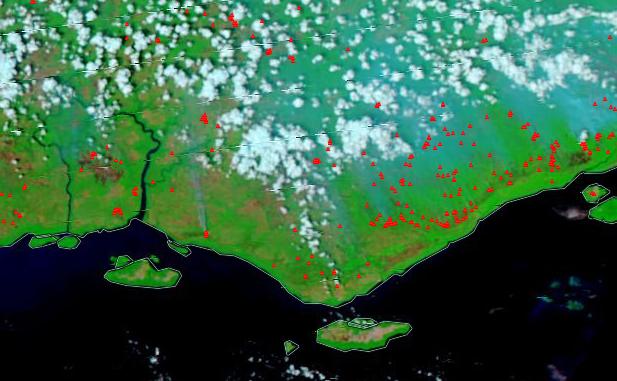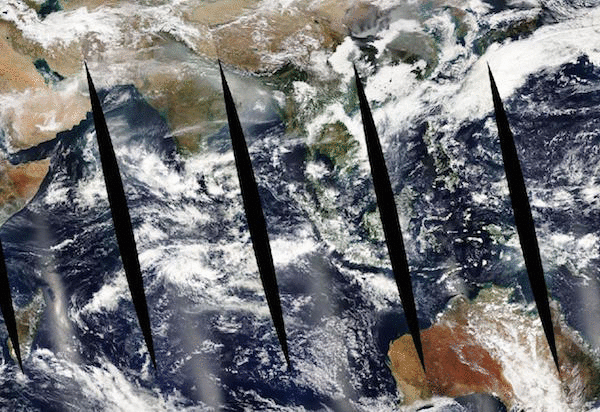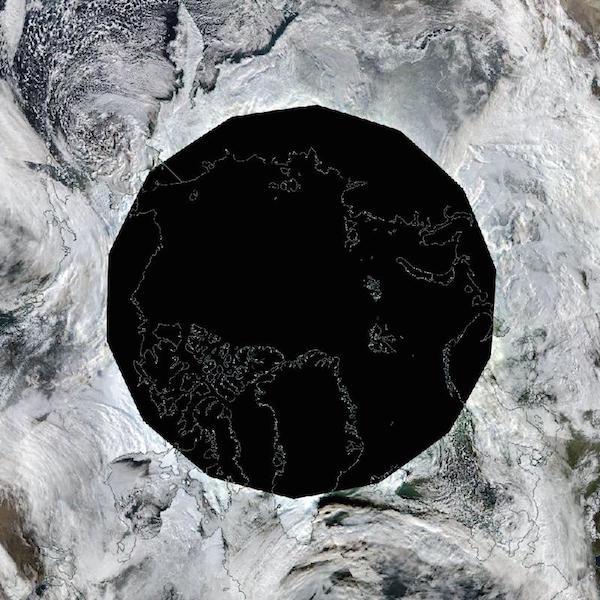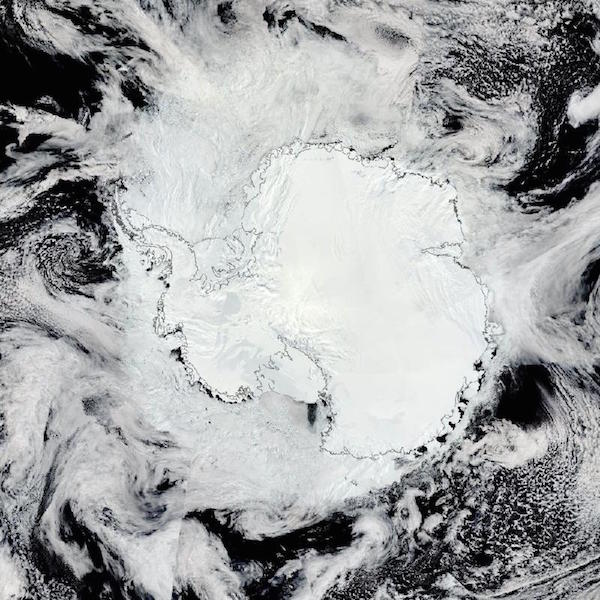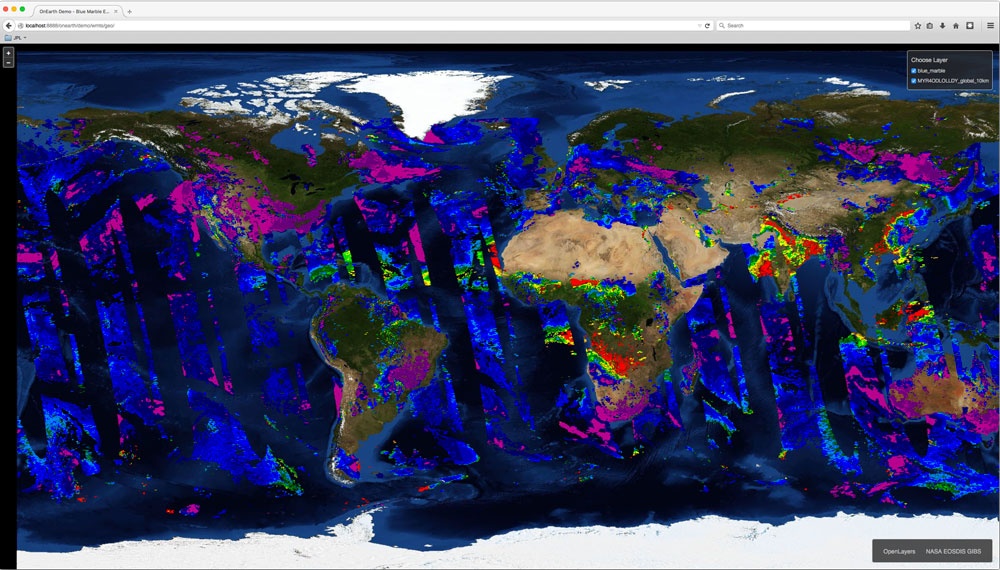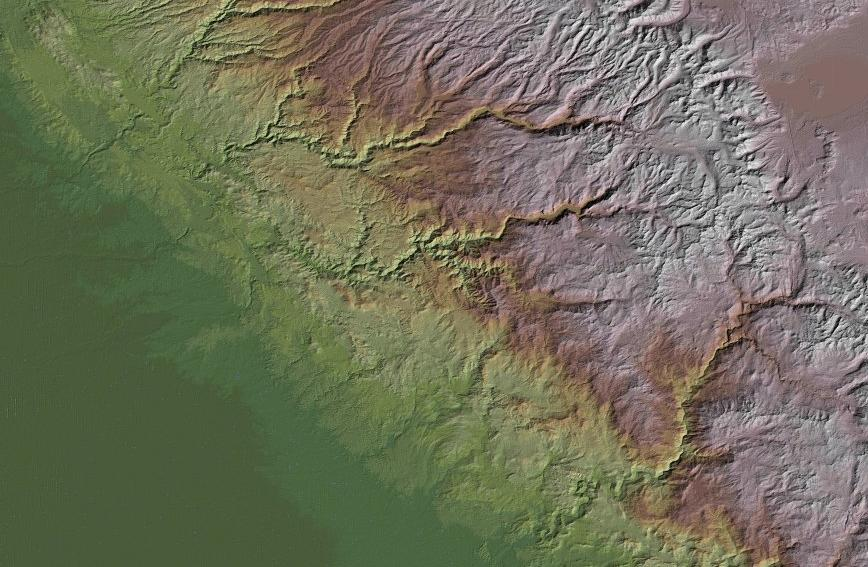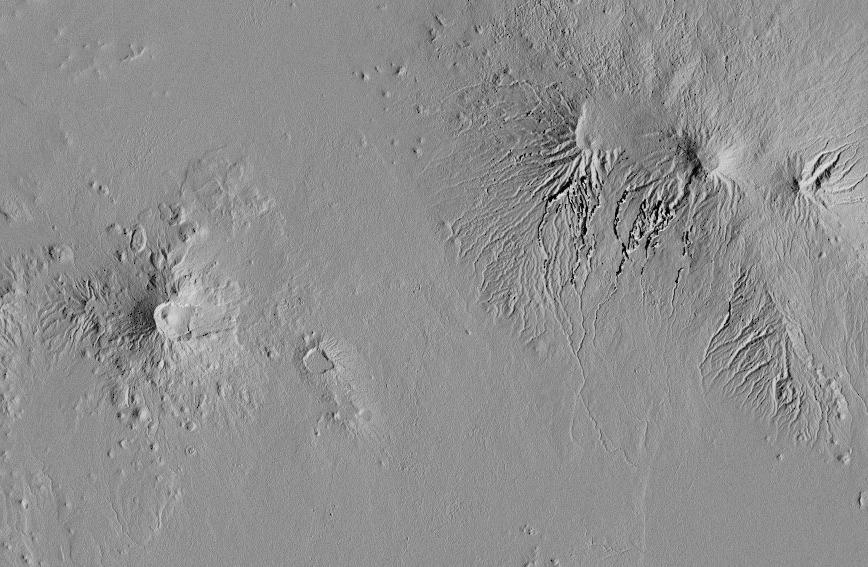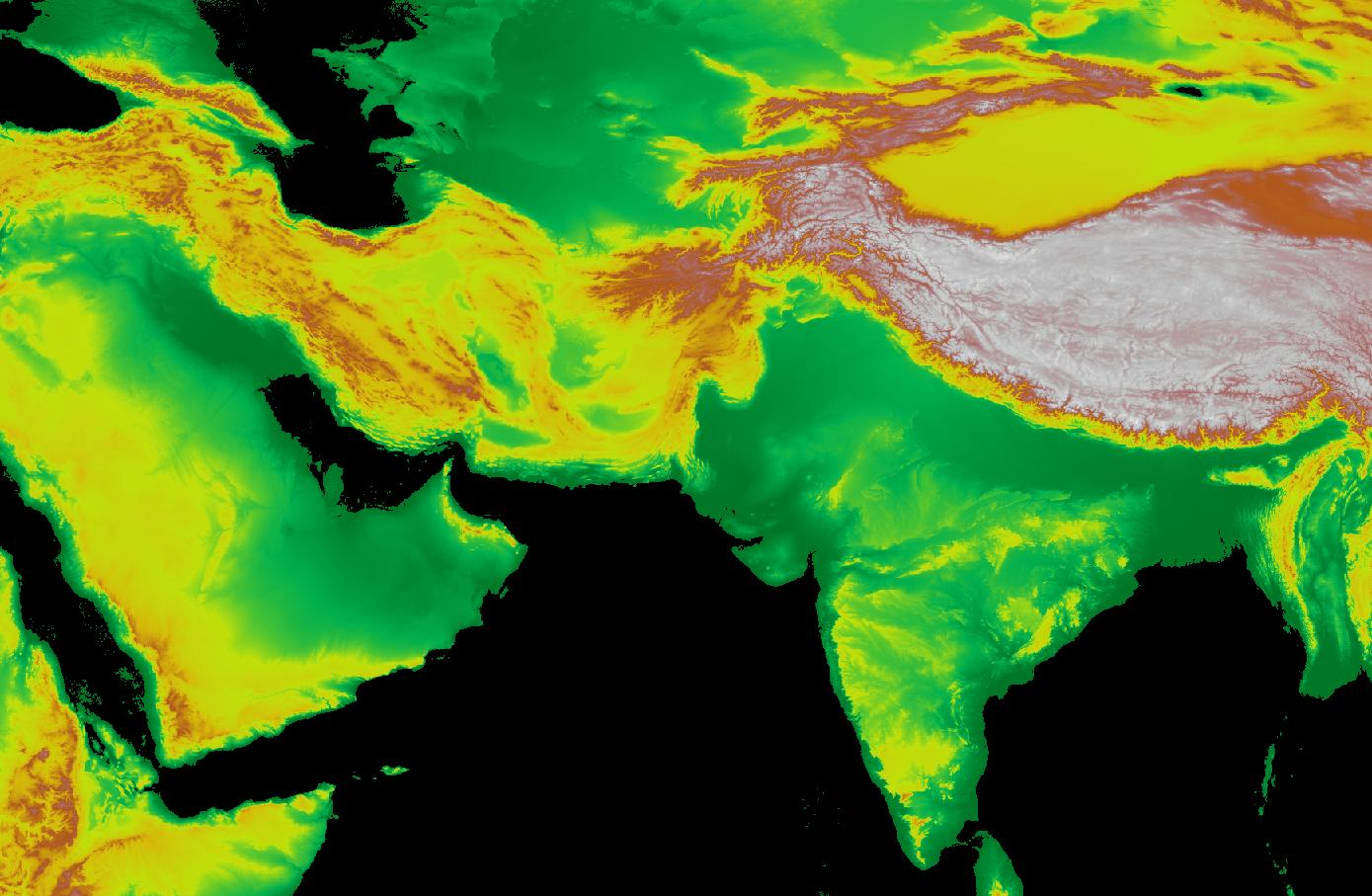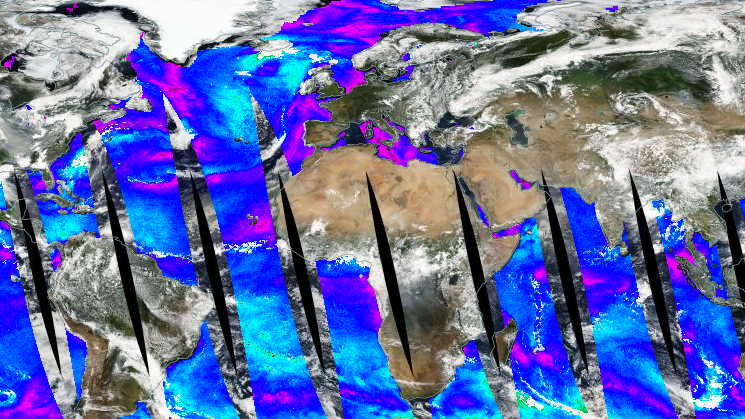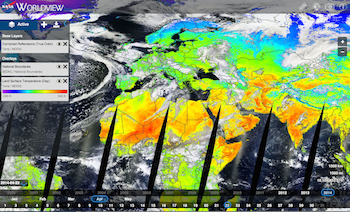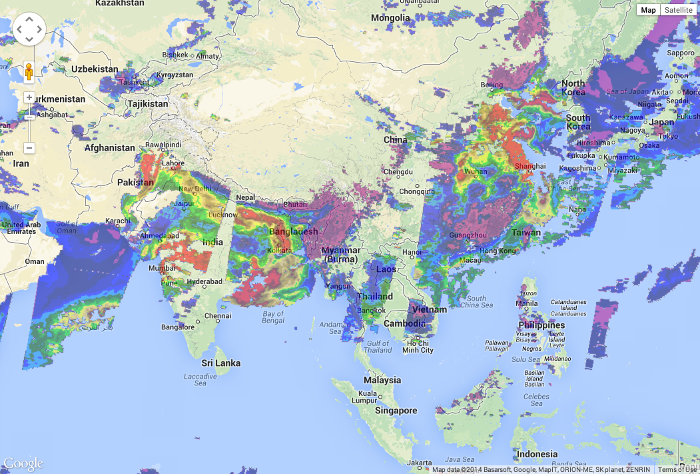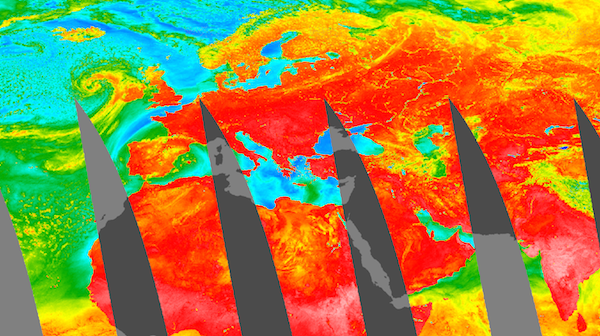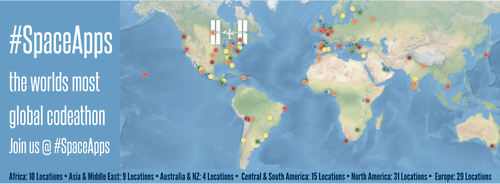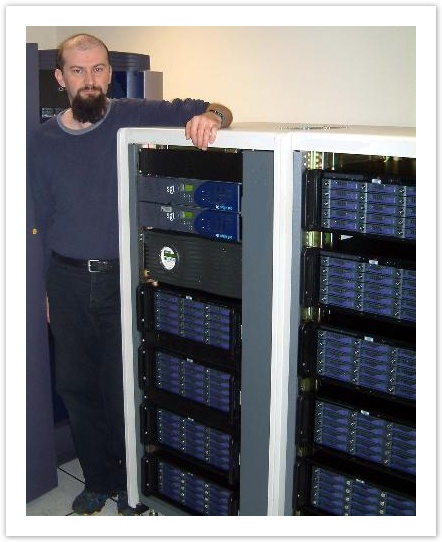Blog
While we love everything that MODIS has done and is still doing after 15+ years (!), we're very excited about the next generation of moderate resolution imagery provided by VIIRS - the Visible Infrared Imaging Radiometer Suite - on the Suomi-NPP satellite! GIBS is now providing daily, global mosaics of VIIRS imagery in full resolution. These include
- Corrected Reflectance (True Color)
- Corrected Reflectance (Bands M3-I3-M11)
- Corrected Reflectance (Bands M11-I2-I1)
- Fires and Thermal Anomalies (Day, 375m)
- Fires and Thermal Anomalies (Night, 375m)
Check them out in Worldview! For this initial release, imagery begins on November 24, 2015 and is being produced in an ongoing basis in near real time - the imagery is available within 3-5 hours of acquisition from the satellite with the goal of reducing that latency further.
VIIRS fires are represented as tiny triangles whereas tiny dots are used for MODIS fires. The first image above shows VIIRS fires + corrected reflectance with true color bands; the second, VIIRS fires + corrected reflectance with M11-I2-I1 bands to show burned areas (reddish brown) and through the smoke.
One of the most visually striking differences between VIIRS and MODIS is that VIIRS has a wider swath which provides full coverage of the globe on a daily basis. Here is a toggle between Aqua/MODIS and Suomi-NPP/VIIRS from December 7, 2015. That wider swath does have a tradeoff, though - the maximum spatial resolution of VIIRS is 375 meters per pixel while MODIS is 250 meters per pixel.
Corrected Reflectance layers are also available in north and south polar stereographic projections. Don't mind the giant area of darkness at the north pole during this time of year! Due to the lack of winter sunlight during satellite overpasses, daytime imagery cannot be collected near the pole.
All layers are now available in Worldview, your GDAL-based scripts, your map clients, etc. We hope you enjoy them as much as we do! Feel free to contact us at support@earthdata.nasa.gov with questions or comments.
We’re pleased to announce the release of OnEarth-Boxes (https://github.com/nasa-gibs/onearth-boxes), a new system that makes it easy to create new virtual machines with pre-configured OnEarth servers for experimentation, education, and development. OnEarth is the lightweight geospatial imagery server used by GIBS to serve hundreds of products to users across multiple map projections.
Using Packer (http://packer.io) virtual machine image creation software, OnEarth-Boxes creates a ready-to-go CentOS6 VM with OnEarth, the MRF imagery storage format, and their dependencies installed and configured. Build scripts are currently included to make VMWare, VirtualBox, and Vagrant/VirtualBox images.
OnEarth-Boxes also includes some demo imagery, accessible through a simple OpenLayers endpoint. WMTS, TWMS/KML, and Mapserver endpoints are pre-configured. Use OnEarth-Boxes to get a feel for how the software works and what its capabilities are without having to integrate it within an existing system.
Since all the OnEarth/MRF utilities are included, OnEarth-Boxes is a great way to quickly get an instance of OnEarth running in order to experiment with your own imagery. Especially when using Vagrant, it’s easy to import new imagery into the VM via a shared folder, create MRFs, and add new layers to OnEarth.
OnEarth-Boxes is also useful as a sandbox for development with OnEarth or MRF. All the source code is included and linked to the Github repo by default, and all the necessary development utilities for compilation and RPM-building are installed.
The Packer build process is highly customizable and allows for easy, repeatable creation of OnEarth VMs by modifying the build parameters and scripts. The Packer infrastructure includes multiple builders and post-processors for a wide variety of VM environments.
To get started with OnEarth-Boxes, visit https://github.com/nasa-gibs/onearth-boxes.
We're pleased to announce the availability of new Global Digital Elevation Models in GIBS from Terra's Advanced Spaceborne Thermal Emission and Reflection Radiometer (ASTER) instrument and the Shuttle Radar Topography Mission (SRTM). These products are available globally at their full resolution of 30 meters per pixel.
The ASTER products were created from approximately 1.5 million scenes (ASTER stereo pair observations) dating back to 2000 and covers land surfaces between 83°N and 83°S. The SRTM product is based on Space Shuttle Endeavour's STS-99 mission in February 2000 using two radar antennas.
Shown above is the ASTER GDEM Color Shaded Relief layer. It shows surface elevation as shaded relief in color. Features such as mountains, valleys, plateaus and canyons with steep slopes will appear more rough, while flat areas will appear more smooth. Areas of lower elevation appear darker green, and areas of higher elevation are reds to white. Areas below sea level are a flat grey.
The ASTER GDEM Greyscale Shaded Relief layer (above) shows surface elevation as shaded relief in shades of grey.
The SRTM Color Index (above) and ASTER GDEM Color Index layers show land elevation around the world, measured in meters. On the default palette, white indicates the highest elevations, then brown, yellow and greens indicate low elevations.
We hope that you'll find good ways to use these with or without your other favorite NASA science data products.
NASA’s Global Imagery Browse Services (GIBS) is your source for visualized radiometer data products from NASA’s Soil Moisture Active Passive (SMAP) mission. Four Level 1 global radiometer products recently have been added to the list of Worldview active layers and can be overlain on the Worldview base image with the click of a button:
- Uncorrected Brightness Temperature
- Uncorrected Brightness Temperature Radio Frequency Interference (RFI)
- Uncorrected Brightness Temperature Quality Assurance (QA)
- Faraday Rotation Angle
All of these products are available in fore and aft views. Uncorrected Brightness Temperature products also are available in H and V polarization. Imagery for these products is available back to July 30, 2015, and is being forward processed. Earlier dates will be added when generated by SMAP’s Science Data System (Figure 1).
Figure 1: The underlying SMAP image data can be downloaded from NASA's National Snow and Ice Data Center (NSIDC) Distributed Active Archive Center (DAAC) by clicking the Worldview "Download Data" button.
Image courtesy of NASA Worldview.
SMAP launched on January 31, 2015, on a three-year mission to provide global soil moisture and freeze/thaw data. The satellite carries two instruments—an active radar and a passive radiometer. SMAP radiometer data have been processed to map microwave emissions from Earth’s surface, which are expressed as brightness temperatures in degrees Kelvin. SMAP’s radar began regular operations on April 13, but stopped transmitting on July 7 due to an anomaly that is still being investigated by the SMAP team at NASA’s JPL.
Getting near real-time data over the oceans just became easier thanks to the addition of 10 new products to NASA’s Global Imagery Browse Services (GIBS). The new products include:
- Columnar Cloud Liquid Water (day/night )
- Columnar Water Vapor (day/night)
- Wind Speed (day/night)
- Surface Precipitation Rate (day/night)
- Surface Rain Rate (day/night)
These products generally will be available within three to four hours of a satellite overpass, and are available for viewing through NASA’s Worldview or similar GIBS client systems.
Wind Speed (Day) is one of 10 new AMSR2 near real-time products available through GIBS. Image courtesy of Worldview.
The products are from data collected by the Advanced Microwave Scanning Radiometer 2 (AMSR2) instrument on the Japan Aerospace Exploration Agency (JAXA) Global Change Observing Mission for Water (GCOM-W1) satellite, and are produced by NASA’s Land, Atmosphere Near real-time Capability for EOS (LANCE) AMSR2 Processing Center at NASA’s Global Hydrology Resource Center Distributed Active Archive Center (GHRC DAAC).
While LANCE near real-time products are not intended to take the place of data products with the detailed processing necessary for scientific research, they are an invaluable resource for users needing rapid, continually updated views of ongoing Earth processes.
We are pleased to announce that two new sets of imagery products are now available in GIBS in the Geographic, North Polar Stereographic, South Polar Stereographic, and Web Mercator projections:
- Aqua / AMSR-E (Advanced Microwave Scanning Radiometer-EOS) Sea Ice consisting of
- Blue Marble: Next Generation consisting of
More details regarding these products are found below:
Aqua / AMSR-E Cryosphere Products
AMSR-E Sea Ice Concentration (12km)
The Advanced Microwave Scanning Radiometer-EOS (AMSR-E) instrument on the NASA Earth Observing System (EOS) Aqua satellite provides global passive microwave measurements of terrestrial, oceanic, and atmospheric variables for the investigation of global water and energy cycles. The Level-3 gridded products (AE_SI6, AE_SI12, AE_SI25) includes brightness temperatures collectively ranging from 6.9 through 89.0 GHz , sea ice concentration, and snow depth over sea ice. Sea ice concentration and brightness temperatures include daily ascending averages, daily descending averages, and daily averages; snow depth over sea ice data is a five-day running average. The GIBS and AMSR team have selected the primary science parameters contained within each gridded product and each spatial resolution for increased visualization usage. Note that the recent reprocessing of the AMSR-E version 3 algorithm includes an improved Antarctic land mask with an updated ice shelf definition, created by the National Ice Center Science Department in June 2011, as well as an updated shoreline developed from ENVISAT and RADARSAT imagery from October 2009 to April 2010.
More information about the AMSR-E Level-3 gridded products is found here. More information about the version 3 reprocessing is found here.
Blue Marble: Next Generation
Blue Marble: Next Generation w/ Topography and Bathymetry (August 2004)
The Blue Marble: Next Generation is a series of images that show the color of the Earth’s surface for each month of 2004 at moderate resolution (500 meters/pixel) at a global scale. These monthly images reveal seasonal changes to the land surface: the green-up and dying-back of vegetation in temperate regions such as North America and Europe, dry and wet seasons in the tropics, and advancing and retreating Northern Hemisphere snow cover. In 2004, the generation of the Blue Marble: Next Generation imagery utilized new techniques allowing the computer to automatically recognize and remove cloud-contaminated or otherwise bad data—a process that was previously done manually. The quality of the Blue Marble imagery was notable for its time. So much so that Steve Jobs and team selected it for the default wallpaper for the Apple iPhone.
GIBS has selected the August monthly imagery for the three static layers available for use. August was selected based on the lower concentration of snow that exposes more land features. The Blue Marble: Next Generation imagery includes the a base image along with bathymetry and topography visual enhancements. These enhancements are described below:
Bathymetry
Bathymetry is a digital image of the undersea land surface and water depth. Bathymetry is the underwater equivalent of land topography. In the maps provided here, shading indicates changes in slope or depth. Much of the data on ocean bathymetry come from "soundings." To collect a sounding, scientists use sonar devices to emit a sound wave that passes into the water. By measuring how long it takes the sound wave to bounce off the ocean floor and return to the sonar, scientists can estimate the depth of the water. Other characteristics of the returned sound wave can help reveal the shape and size of features on the sea floor. These images represent ocean depths between -8000m and 0m (surface).
Topography
Land topography is a digital image of the three-dimensional structure of the Earth's surface. Shading indicates changes in slope or elevation. The relief shading in this topographic map comes mostly from elevation data collected by space-based radars. Topography not only gives a realistic picture of what the Earth's surface actually looks like, it also helps scientists determine things like how rivers and streams drain through the landscape, where lowlands are prone to flooding, how plate tectonics or erosion are building or wearing away mountains, where hills may be prone to landslides, or how a volcanic eruption changed the shape of a mountain. Topography is also one of the factors that influences where particular ecosystems exist. Therefore topography is one of the factors that scientists can use to predict where certain plants or animals, such as endangered species, might be found.
More information about the Blue Marble: Next Generation imagery products can be found here.
As a long overdue announcement, source code to the EOSDIS Worldview satellite imagery browsing tool is available on GitHub as of April 22, 2014.
↓
https://github.com/nasa-gibs/worldview
Worldview was originally created to be a reference client to "keep the Global Imagery Browse Services (GIBS) honest" by ensuring its services are usable for client developers. From a user perspective, it provides a mechanism to visually discover "interesting" phenomena within EOSDIS imagery, download that imagery, and also download the underlying data granules which generated the imagery.
We hope that the release of this source code will encourage other client developers to reuse and build upon this work for their own needs. Or if something simpler is needed to start with, there are always the barebones GIBS Web Examples for integrating GIBS imagery with Leaflet, OpenLayers, Google Maps, and Bing Maps.
For questions or comments, please contact us at support@earthdata.nasa.gov.
MODIS Aerosol Optical Depth mashed with Google Maps
The GIBS team is pleased to announce the availability of imagery in the Web Mercator / Google Maps / EPSG:3857 / EPSG:900913 map projection in addition to the already-supported Geographic (EPSG:4326), Arctic Polar Stereographic (EPSG:3413), and Antarctic Polar Stereographic (EPSG:3031) projections. This now enables integration of GIBS imagery with widely-used maps such as Google Maps, Bing Maps, and OpenStreetMap up to zoom level 9.
We've updated our API documentation, GIBS Web Examples on GitHub, and live demos such as Leaflet, Google Maps, and Bing Maps. We look forward to seeing what you build!
Please note that currently the "leading edge" of new Web Mercator imagery is available 2-4 hours after the Geographic imagery is produced for a total latency of 5-9 hours from the time the satellites capture the imagery until it is available in GIBS. Please also note that zoom level 0 (the top tile) is not currently supported.
Questions or comments? Write us at support@earthdata.nasa.gov.
We are pleased to announce that two new sets of imagery products are now available in GIBS:
- Aqua / AMSR-E (Advanced Microwave Scanning Radiometer-EOS) Brightness Temperature consisting of
- MEaSUREs (Making Earth System Data Records for Use in Research Environments) Global Record of Daily Landscape Freeze/Thaw consisting of
These products mark two milestones for the GIBS project:
- Imagery has been visualized and is available for every day throughout the entire MEaSUREs Freeze/Thaw and AMSR-E Brightness Temperature mission. Most of the other products in GIBS do not yet contain imagery from the entire mission duration.
- The Freeze/Thaw product is the first of many MEaSUREs datasets to be visualized and made available through GIBS.
More details regarding these products are found below:
Aqua / AMSR-E Brightness Temperature
AMSR-E Brightness Temperature (89H GHz B Scan, Day), 2003-05-07
The (AMSR-E) instrument on the NASA Earth Observing System (EOS) Aqua satellite provides global passive microwave measurements of terrestrial, oceanic, and atmospheric variables for the investigation of global water and energy cycles. The AMSR-E Level-2A product (AE_L2A) contains horizontally and vertically polarized brightness temperature measurements at 6.9 GHz, 10.7 GHz, 18.7 GHz, 23.8 GHz, 36.5 GHz, and 89.0 GHz. The GIBS and AMSR-E team have selected the 89.0 GHz horizontal and vertical parameters for visualization. These measurements provide the highest level of data resolution from the available scan channels. More information can be found here.
MEaSUREs Freeze/Thaw
Key: Blue = Frozen. Red = Thawed, Olive = Transitional, Bright Green = Inverse Transitional
MEaSUREs Daily Landscape Freeze/Thaw, SSM/I-SSMR, 2004-02-24
MEaSUREs (Making Earth System Data Records for Use in Research Environments) products are generally created by linking together multiple satellites into a constellation, creating a longer-running, consistent data record. The MEaSUREs Freeze/Thaw product is a Global Record of Daily Landscape Freeze/Thaw created from a Scanning Multichannel Microwave Radiometer (SMMR) and Special Sensor Microwave/Imager (SSM/I) record for the years 1979 to 2010; and an Advanced Microwave Scanning Radiometer - Earth Observing System (AMSR-E) record for the years 2002 to 2011. The goal of the product is to quantify global vegetated land surface freeze/thaw state dynamics over a long-term data record of more than 25 years. More information can be found here and here.
The GIBS team is pleased to announce the operational deployment of the latest version of the OnEarth imagery access software, version 0.2.5. Source code and installation RPMs are available through the OnEarth GitHub repository The GIBS team has performed both functional and performance tests against this release in preparation for this deployment. The highlighted enhancements included in this release are listed below:
- WMTS and TWMS key-value pair URL parameters may now be supplied in any order and the keys are case insensitive.
- The WMTS and TWMS 'format' parameter may contain either an escaped ('%2F') or non-escaped ('/') backslash when specifying the image format (e.g. 'image/png').
- Enhanced error handling has been added for invalid requests to better assist GIBS client developers and image consumers in identify invalid image request URLs. More details are available on OnEarth GitHub wiki.
For questions regarding this release or other GIBS-related topics, please contact the GIBS team at support@earthdata.nasa.gov.
Stay tuned for more announcements in the coming week for new products and imagery projections.
NASA's Global Imagery Browse Services (GIBS) will be participating in the 2014 International Space Apps Challenge, a global hack-a-thon to build open source solutions to space- and Earth-related needs over the weekend of April 11-13. NASA is organizing the event in collaboration with other government agencies and local organizations. Over the course of 48 hours, teams collaborating in cities and virtually will compete to build the best solutions to one of 40 challenges. Winners from each location will be judged locally; those winners will then be evaluated against each other globally in five categories: Best Use of Hardware, Best Use of Data, Most Inspiring, Galactic Impact, Best Mission Concept.
GIBS is providing three of the challenges for participants to address:
- A Picture is Worth a Thousand Words: build a mashup which integrates NASA imagery with data sets of your choice to tell a compelling story and allow others to interactively explore it.
- Animate Your World: build a cloud-free animation, share a satellite story, or knock our socks off! Using the GIBS API, build a web or mobile app which uses NASA imagery to show our planet in motion.
- Image-ine Earth Yesterday and Today: dream big! Considering the imagery that's available now and in the future, sketch out a prototype which uses GIBS to do something new.
We'll be online to answer questions to the above challenges along with participating in person at the Washington, DC / Baltimore location. We hope to see you there or online!
Based on feedback from the aerosol community, GIBS will be expanding the data range and palette of the MODIS Aerosol Optical Depth products which include
- Terra / MODIS Aerosol Optical Depth
- Aqua / MODIS Aerosol Optical Depth
- Terra and Aqua / MODIS Combined Value-Added Aerosol Optical Depth
The currently displayed data contains the range 0.25 to 0.70. For this update, the lower end of the range will be expanded, making the overall range -0.05 to 0.70.
The current, "old" range:
The updated, "new" range:
Note that the colors will remain the same for values of 0.25 and higher.
The change is scheduled to occur on 2014 March 13 around noon Eastern Time. Please contact us at support@earthdata.nasa.gov with any questions.
We're pleased to announce the open source release of the GIBS tiled imagery server and its underlying tile storage format on GitHub!
What is it?
The "OnEarth" software is used as the Global Imagery Browse Services (GIBS) primary imagery server for a highly responsive, highly scalable service which provides client access via Open Geospatial Consortium (OGC) Web Map Tile Service (WMTS), Tiled Web Map Service (TWMS), and Google Earth KML methods along with scripted access via GDAL. It also supports time-varying access to individual layers which has been a necessity for this project in dealing with long-running, daily satellite imagery.
Also included in this release is an optimized image tile storage format called Meta Raster Format, or MRF, and scripts to generate them. It's designed to reduce file system overhead by combining all tiles for a given layer into a single file similar to MapBox MBTiles. It supports arbitrary map projections and is currently being used by GIBS for storing its geographic, Web Mercator, Arctic, and Antarctic tiles. As a plugin for GDAL, MRFs can also be read by GDAL-based applications such as MapServer.
Battle Tested
While this release is new, the software itself has a long heritage at NASA's Jet Propulsion Laboratory. Along its travels, it has had the distinction of serving the largest image in the world at the time (a Landsat mosaic of the US circa 1998), the Earth imagery server for planetarium shows at the American Museum of Natural History (2003-present), the first 15m global Landsat mosaic of the world (2004), the original imagery and terrain server for NASA World Wind (2004), and a Martian and Lunar imagery server (2008?-present). Since 2011, it has been a collaborative project between NASA/Goddard and NASA/JPL as the primary Earth imagery server for GIBS.
40TB of OnEarth imagery storage in 2003
100TB+ of OnEarth imagery storage in 2014
Future Plans
Updates this spring will include some long-awaited fixes to improve WMTS compatibility (e.g., case insensitivity, flexible key-value pair ordering, improved error handling). Features we are considering for the future include native REST support for WMTS, dynamic band combinations, low-bandwidth pre-composited images, and on-the-fly palette updating. We look forward to engaging with the FOSS community in making these features a reality.
Bonus
We've also posted sample web clients and their code which use OpenLayers and Leaflet to interactively browse imagery from GIBS. Give them a fork and let us know what you build!
https://github.com/nasa-gibs/gibs-web-examples
We hope that the public release of this software will encourage further armchair exploration of the Earth and other planets through interactive geospatial mapping.
https://github.com/nasa-gibs/onearth
Contact us at support@earthdata.nasa.gov with questions or comments.
We have been working to continue the evolution and compliance with the WMTS specification. The following email outlines two areas in which we have modified our WMTS compliance. For additional information, please refer to the GIBS documentation located at http://earthdata.nasa.gov/gibs.
Time Dimension
Unique to the GIBS implementation of the WMTS specification is the underlying data's dependence upon date. GIBS imagery provides a full global image for every day, unlike static maps like Bing or Google Maps. Previously, the GIBS WMTS endpoint utilized an additional, unspecified, parameter for time. Our WMTS GetCapabilities responses now include a formal time dimension within each layer's definition. A sample Dimension block is shown here:
<Dimension>
<ows:Identifier>time</ows:Identifier>
<UOM>ISO8601</UOM>
<Default>2013-05-29</Default>
<Current>true</Current>
<Value>2012-05-08/2013-05-29/P1D</Value>
</Dimension>
(Note: "2012-05-08" and “2013-05-29” will be replaced by the layer's start and end UTC date, respecitvely)
The parts of the Dimension data structure are taken from the WMTS 1.0.0 spec (Table 9, p. 22). However, since the WMTS spec doesn't address the time dimension (other than the use of "Current"), we are adapting some aspects of the WMS spec regarding the time dimension, specifically:
- The contents of the <UOM> part match the contents of the "units=" attribute in the WMS <Dimension> element.
- The contents of the <Value> part match the contents of the WMS <Extent> element.
If the time dimension is omitted in the WMTS request, tiles for the current UTC date will be returned. Be aware that many of the current date’s tiles will be empty because the imagery is generated as the satellites orbit from east to west.
We are working with the OGC WMS SWG to continue to growth of the WMTS standard and specifically to deal with limitations like this that we run into.
RESTful Access
In addition, our WMTS now supports RESTful requests as specified in the GetCapabilities document:
The template is of the form:
and a sample request is:
If you have any questions, please contact support@earthdata.nasa.gov
In coordination with the Microwave Limb Sounder (MLS) team, the following MLS products are available through the GIBS image access APIs. A Day and Night imagery layer are available for each product in the EPSG:4326 geographic "projection". The hyperlinks in the following list take you to the NASA Worldview client where you can view the new imagery.
- Carbon Monoxide (CO) at 215 hPa
- Water Vapor (H2O) at 46 hPasup
- Nitric Acid (HNO3) at 46 hPa
- Nitrous Oxide (N2O) at 46 hPa
- Ozone (O3) at 46 hPa
- Sulfur Dioxide (SO2) at 147 hPa
- Temperature at 46 hPa
As always, the full listing of GIBS products can be found on the Earthdata website. If you have any questions, contact us at support@earthdata.nasa.gov.
